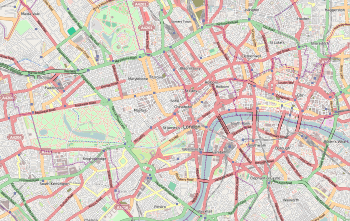Bond Street tube station
| Bond Street | |
|---|---|
|
Western entrance through West One arcade | |
 Bond Street Location of Bond Street in Central London | |
| Location | Oxford Street |
| Local authority | City of Westminster |
| Managed by | London Underground |
| Number of platforms | 4 |
| Fare zone | 1 |
| London Underground annual entry and exit | |
| 2012 |
|
| 2013 |
|
| 2014 |
|
| 2015 |
|
| Key dates | |
| 1900 | Opened (Central line) |
| 1979 | Opened (Jubilee line) |
| Other information | |
| Lists of stations | |
| WGS84 | 51°30′50″N 0°09′00″W / 51.514°N 0.15°WCoordinates: 51°30′50″N 0°09′00″W / 51.514°N 0.15°W |
|
| |
Bond Street is a London Underground and future Crossrail station on Oxford Street, near the junction with New Bond Street. Note that the street-level entrances are approximately 200 metres west of New Bond Street itself. The actual entrance to the station is inside the West One shopping arcade on the corner of Oxford Street and Davies Street.
The station is on the Central line between Marble Arch and Oxford Circus and on the Jubilee line, between Baker Street and Green Park. It is in Travelcard Zone 1.
History
The station was first opened on 24 September 1900 by the Central London Railway, three months after the first stations on the Central line opened.[2] The surface building was designed, in common with all original CLR stations, by the architect Harry Bell Measures. The original plans for the railway included a station at Davies Street rather than Bond Street.[2]
The station has seen several major reconstructions. The first, which saw the original lifts replaced by escalators, a new sub-surface ticket hall and a new façade to the station, designed by the architect Charles Holden, came into use on 8 June 1926. This was demolished with the construction of the "West One" shopping arcade in the 1980s, a period that had also seen the Jubilee line services to this station commence on 1 May 1979. Some slight elements of the original facade do survive above the eastern entrance to the station. In 2007 the station underwent a major modernisation, removing the murals installed on the Central line platforms in the 1980s and replacing them with plain white tiles, in a style similar to those when the station opened in 1900.
In 1920 a possible joint venture had been considered between London Underground and the nearby Selfridges store to rebuild the station, including an entrance in Selfridge's basement, was mooted. The concept was revisited in the early 1930s, leading to a concept of a subway connecting the station to the store, with a new ticket office in the basement of Selfridge's. However, these plans did not work out, probably due to the cost of the construction.[3]
Connections
London Buses routes 2, 6, 7, 10, 13, 23, 30, 73, 74, 82, 94, 98, 137, 139, 159, 189, 274 and 390 and night routes N2, N7, N13, N73, N98 and N207 serve the station.
Future developments
Crossrail line 1 will call at Bond Street. Services are due to commence in 2018.[4] The station will be reconstructed to accommodate the extra platforms and increased pedestrian traffic. This will include a new street level entrance on the north side of Oxford Street.[5] The station is to become one of many newly made "step free" stations. This means that there will be lifts to provide a step free way to access the platforms. Engineers and architects undertaking work on the station include Abbey Pynford,[6] John McAslan [7] and Lifschutz Davidson Sandilands.[8]
Nearby places of interest
- Bond Street
- Claridge's Hotel
- Handel House Museum, Brook Street
- Wallace Collection, Manchester Square
- Wigmore Hall, Wigmore Street
- US Embassy, Grosvenor Square
Cultural references
The station and line are mentioned in the refrain to the 1969 Sweet Thursday song "Gilbert Street".
Gallery
- Central line westbound platform looking east
- Central line roundel, westbound platform
 Tile-work on Jubilee line platform
Tile-work on Jubilee line platform
References
- 1 2 3 4 "Multi-year station entry-and-exit figures" (XLS). London Underground station passenger usage data. Transport for London. April 2016. Retrieved 3 May 2016.
- 1 2 Henry Eliot and Tom Meltzer (9 January 2013). "What to see near Bond Street: a guide to London by tube". The Guardian. Retrieved 14 January 2014.
- ↑ "Bond Street tube station's private tunnel to Selfridges". Ian Visits. 28 November 2016.
- ↑ "Capital's key services protected, says Johnson". The Press Association. 20 October 2010. Retrieved 21 October 2010.
- ↑ Elizabeth line proposals
- ↑ Cole, Margot (21 February 2013). "Millions of good reasons to modernise". New Civil Engineer. Retrieved 2 December 2014.
- ↑ http://www.ribaj.com/culture/julian-robertson-crossrail
- ↑ http://www.propertyweek.com/news/news-by-region/london/reworked-hanover-square-plans-approved/5073540.article?utm_campaign=LatestNews+&utm_source=PWNews+&utm_medium=Twitter+
External links
| Wikimedia Commons has media related to Bond Street tube station. |
| Preceding station | Following station | |||
|---|---|---|---|---|
| Central line | ||||
towards Stanmore | Jubilee line | towards Stratford |
||
| Future development | ||||
| Preceding station | Following station | |||
| Crossrail Elizabeth line | ||||